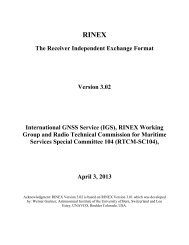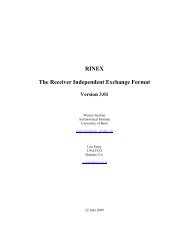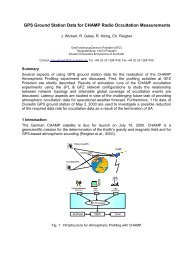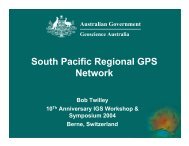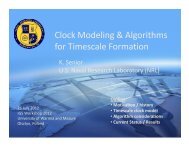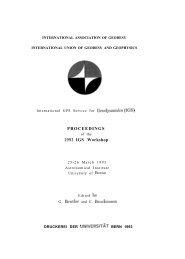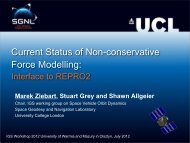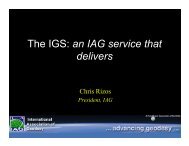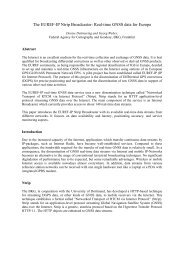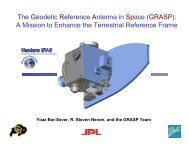ecause of the above averaging. This confirms that:x~ (t) = ~ k ix i () t ,i=lalso satisfies the equation of motion provided that the weights ki are constant, ~ki = 1 and(Xi (t) - X~ (t)) are small.The second and more elegant approach is to combine initial satellite state vectors and associatedsolar pressure parameters. Under certain conditions this approach is equivalent to the introductionof individual orbit series as pseudo-observations into an orbit improvement program. This is theapproach proposed in Beutler et al. (1993) and further pursued in Section 3. The advantage of thisorbit combination method is that orbital dynamics is maintained. Furthermore, arcs longer than 24hours are possible (with less discontinuities), reliability is increased (even when all <strong>Center</strong>s arebiased on the same day a correct solution, compatible with the neighboring days, is still possible)and this approach is directly compatible with a future rigorous/distributed processing. Thedisadvantages are the increased complexity and the requirement for a different algorithm for clockprocessing.For both approaches it is essential that small systematic differences in coordinate and timereference frames are reconciled before any weighting is applied to ensure unbiased estimation in aconsistent reference frame. This is a complex problem which requires a close cooperation withIERS and for the time with BIPM (Bureau International des Poids et Mesures). For orbitcombinations it can approximately and implicitly be accomplished through a set of constrainedtracking station positions, which are well determined and maintained by IERS to be compatiblewith IERS EOP. This is, in fact the practice already in effect. Additionally, the individual <strong>Center</strong>EOP solutions can be used here for removing further small differential rotations around X- and Y-coordinate axes, assuming that the corresponding orbits and EOP are consistent which may not betrue for some <strong>Center</strong>s (Springer and Beutler, 1993): Small unexplained systematic differences canalso be determined from previous and current orbit comparisons/ determinations along with longterm statistics. These can be used for apriori parameters and weighting in an orbit combinationadjustment. In this way, in an average sense, the proper reference frame would be maintained andused and no EOP parameters would be required. Another possibility is to use, for the apriori X andY rotation parameters, the average pole offsets as determined by IERS for each <strong>Center</strong>. The timereference ideally should be compatible with UTC as determined by BIPM. In fact BIPMinvolvement in <strong>IGS</strong> would be mutually beneficial, as <strong>IGS</strong> could provide clock transfer and timesystem consistency better than one ns, which is almost an order of magnitude improvement withrespect to the current state of the art time transfer capability and reference time maintenance. BIPMin return could provide precise time reference for <strong>IGS</strong>.Operationally, a combination of the above two methods maybe desirable. The first approach canprovide a quick look and feed back, it can also handle the reference frame transformation,appropriate weighting, blunder detection and rejections, etc. Then, the weighted average orbit canbe introduced into the second approach, providing additional quality check and producing the final<strong>IGS</strong> orbit consistent with satellite dynamics. The quality of the proposed <strong>IGS</strong> combined orbits istested in Section 4 by processing several continental baselines. Finally, in Section 5, a combinationof satellite clock solutions is considered, which is similar to the orbit combination of Section 2.23
2. ORBIT COMBINATION BY WEIGHTED AVERAGE2.1 Method DescriptionThe first attempt to combine orbits from different <strong>IGS</strong> Processing <strong>Center</strong>s was made at CODE atthe beginning of 1993. For the description and principles of the method used see Springer andBeutler (1993). The combined orbits were obtained as weighted averages of the orbits computedby different <strong>IGS</strong> Processing <strong>Center</strong>s. However, before such orbit combination, small differences inreference frames had to be removed. This was accomplished in two stages. First, the differencesbetween the corresponding EOP solution and the chosen reference pole were used to rotate therespective orbits around the X and Y axes. Second, to remove the remaining reference framemisalignment, a seven parameter Helmert transformation was then estimated for every <strong>IGS</strong> <strong>Center</strong>during the orbit combination.For the weighted orbit combination, satellite and <strong>Center</strong> specific weights are also required. The<strong>Center</strong> specific weights can easily be obtained from previous combinations and/or orbitcomparisons. For the satellite weights the previous experience may not be meaningful. In the firstorbit combination attempt, the weights for both satellites and the <strong>Center</strong>s were determined in thefirst iteration and then applied in the second iteration. The Helmert transformation parameters werethen estimated by the weighted least squares adjustment, also know as the L2-norm. For the currentorbit combination an L1 - norm (Press et al., 1989), also known as a robust estimator, was adoptedas proposed by Prof. C.C. Goad. The L1 -norm is less sensitive to outliers than the L2-norm,therefore ‘bad’ satellites do not disturb the estimated parameters, thus making the satellite specificweights unnecessary, provided that most satellites are of comparable quality. In the case when mostsatellites are ‘bad’ the L2 norm and satellite specific weighting are required. Using this technique,orbit combinations were performed for all the days up to September 4, 1993 and also for the orbitsfrom the January 1993 Orbit Test. Both combinations are analyzed in the following two sections..2.2 Results for the 1993 orbit combinationsTable 2.1 shows the number of orbits processed during GPS weeks 678-712, the mean and thecorresponding standard deviations of the seven Helmert parameters for each of the current <strong>IGS</strong><strong>Analysis</strong> <strong>Center</strong>s. These values are with respect to the combined orbits. In this table the averagecoordinate RMS is intentionally left out as it tends to get corrupted by ‘bad’ satellites. However,based on the results of the last few months the following average coordinate RMS values wereobserved for the currently contributing <strong>Center</strong>s: below 20cm for COD, EMR, GFZ, JPL, below 35for ESA, S10 and below 50 cm for NGS. The RMS is normally well below this value as can be ●seen in Figure 2.1. Note that some large outliers have been removed from the plot and theremaining large RMS values are, in nearly all cases, due to either Anti-Spoofing (AS) or little orno data for a particular satellite.24
- Page 1 and 2: ●INTERNATIONAL ASSOCIATION OF GEO
- Page 3 and 4: TABLE OF CONTENTS.FINAL AGENDA . .
- Page 5 and 6: 13:30 NGS14:00 S1014:30 EMR15:00 CO
- Page 7 and 8: LIST OF PARTICIPANTS:Prof. Gerhard
- Page 10 and 11: Table 1. Current IGS Analysis Cente
- Page 12 and 13: The first field identifies the reco
- Page 14 and 15: Summary InformationThe third produc
- Page 16 and 17: From Figure 1 we find that there ar
- Page 18: to define a reference clock in thei
- Page 22 and 23: SESSION 2(IGS orbit products)
- Page 24 and 25: 1. introductionThe main objectives
- Page 28 and 29: RMS per center (m)o 0 0 0 0 0 oA0Iv
- Page 30: Scale (ppb)I I I I I 11+-b~ul0Amo&I
- Page 33 and 34: and NGS. Note that the day to day v
- Page 35 and 36: Rotation around X-axis (mas)1&0 0o
- Page 37 and 38: discussed in Section 3 are here see
- Page 39 and 40: -----------------------------------
- Page 41 and 42: Residuals in Meters1 1 1 1 1 1 1=%m
- Page 43 and 44: Residuals inMeters11111cnficJJw-o A
- Page 45 and 46: I I I—Residuals in Meters..—.
- Page 47 and 48: 1111ResidualsMeters,—{44
- Page 49 and 50: Residuals in MetersI I I II I I IIc
- Page 51 and 52: Rms in MetersI 1 ! I 1 10 n0 a0n.ff
- Page 53 and 54: IGS- and the COM-sets, but that the
- Page 55 and 56: Table 4.1 N.A. Baseline Repeatabili
- Page 57 and 58: ..Figure 5.1:Clock solutions for FA
- Page 59 and 60: specifically the preanalysis can be
- Page 61 and 62: discussion, a question as to whethe
- Page 63 and 64: SUMMARY OF SESSION 3This Session be
- Page 65 and 66: IGS POSITION PAPER, IGS ANALYSIS CE
- Page 67 and 68: and Earth orientation parameters (E
- Page 69 and 70: LbPIERS and IGSCentral Bureausand D
- Page 71 and 72: @ IGS will develop instructions, an
- Page 73: 2.2 Analysis Center System DesignFi
- Page 76 and 77:
applied to the solution in order to
- Page 78 and 79:
..standard deviations. This is conv
- Page 80 and 81:
known, the two solutions will be ad
- Page 82 and 83:
errors, and can therefore be used a
- Page 84 and 85:
International Terrestrial Reference
- Page 86 and 87:
Thus, there is the potential of fee
- Page 88 and 89:
90” 100” 110” 120” 130” 1
- Page 91 and 92:
adiation parameters for each satell
- Page 93 and 94:
Bock, Y., R.I. Abbot, C.C. Counselm
- Page 95 and 96:
SUMMARY OF SESSION 4This session st
- Page 97 and 98:
INTERNATIONAL EARTH ROTATION SERVIC
- Page 99 and 100:
x- differences with IERS0.001”I I
- Page 101 and 102:
SUMMARY OF SESSION 5In the last ses
- Page 103 and 104:
1) I(X3 PROCESSING/REPORTS/FORMATSS
- Page 105 and 106:
IGS should foster and encourage reg
- Page 107 and 108:
..INTERNATIONAL GPS SERVICE FORGEOD
- Page 109 and 110:
ortL.s.4
- Page 111 and 112:
1234567a91011121314IsIt17ItIs2C2122
- Page 113 and 114:
. Ruth Neilan16S Central BureauJet
- Page 115 and 116:
ON1T.>● Jim ZumbergeJet Propulsio
- Page 117:
PROPOSED ORGANIZATION OF THE INTERN




